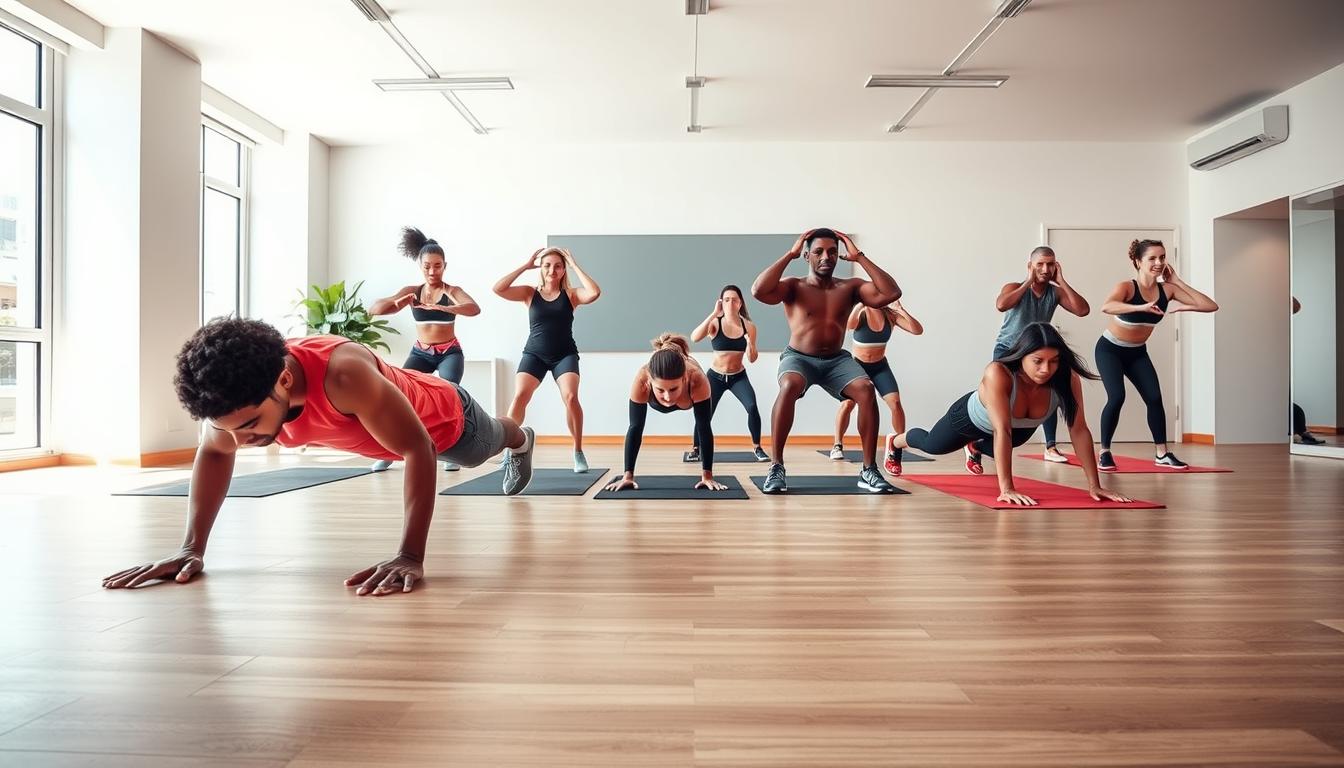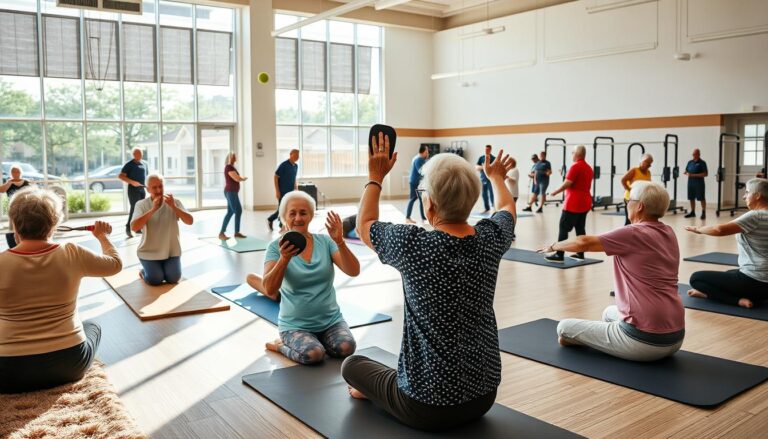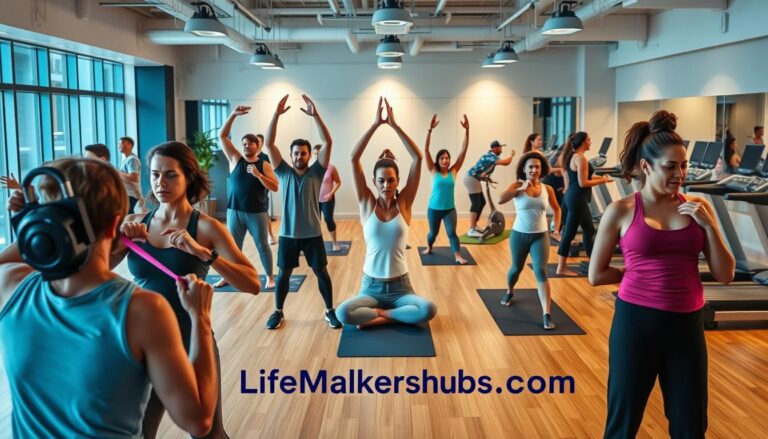Effective No-Equipment Home Workouts for Weight Loss
Staying fit doesn’t require a gym membership or expensive equipment. With bodyweight exercises, you can achieve your fitness goals anywhere—whether it’s your living room, a park, or even a small office space. These routines are simple, accessible, and designed to help you burn fat and build muscle using just your body’s weight1.
Bodyweight training is a versatile way to improve strength, endurance, and overall fitness. Exercises like squats, lunges, and planks target multiple muscle groups, making them efficient for busy schedules. Plus, they can be adapted to any fitness level, from beginners to advanced2.
Combining these exercises with proper nutrition is key to success. Experts suggest that diet plays a significant role in achieving weight loss goals, while strength training complements this effort1. Whether you’re looking to tone up or boost your heart health, bodyweight routines offer a practical solution.
Key Takeaways
- Bodyweight exercises are simple and require no equipment.
- These routines can be done anywhere, making them highly accessible.
- Combining exercise with proper nutrition is essential for success.
- Bodyweight training improves strength, endurance, and overall fitness.
- Exercises like squats and planks target multiple muscle groups.
Getting Started with “No-equipment home workouts for weight loss”
Starting a fitness journey doesn’t have to be complicated or costly. Bodyweight exercises are a practical way to build strength, improve endurance, and burn calories—all without needing any equipment. These routines are versatile, adaptable, and perfect for beginners or those looking to stay active at any fitness level.
Understanding the Basics
Bodyweight exercises use your own weight to create resistance, targeting multiple muscle groups. Moves like squats, lunges, and planks engage your core, legs, and upper body, making them efficient for full-body training. Beginners can start with assisted squats or knee push-ups to build confidence and strength3.
Proper form is essential to prevent injury and maximize results. For example, during a squat, keep your knees aligned with your toes and your back straight. Small adjustments like these ensure you’re working the right muscles and staying safe.
Setting Realistic Goals
Setting achievable goals is key to staying motivated. Start with manageable routines, like 10-15 minutes of exercise a day, and gradually increase intensity. Tracking your progress—whether it’s reps, time, or consistency—helps you stay on track and celebrate small wins4.
Consistency is more important than intensity. Even simple changes, like walking 10,000 steps daily or cutting out late-night snacks, can lead to significant results over time4. Focus on building habits that fit your lifestyle and schedule.
Remember, fitness is a journey, not a race. Celebrate every step forward, and don’t be afraid to adjust your goals as you progress. With patience and persistence, you’ll see the results you’re working toward.
The Benefits of Home Workouts for Weight Loss
Achieving fitness goals is easier than ever with the flexibility of at-home routines. Whether you’re short on time or prefer the comfort of your own space, these exercises offer a practical way to stay active and healthy. Plus, they eliminate the need for expensive gym memberships or equipment5.
Increased Convenience and Flexibility
One of the biggest advantages of exercising at home is the convenience it offers. You can fit in a quick session during lunch, early morning, or even late at night. There’s no need to commute or wait for equipment, saving you valuable time6.
This flexibility also makes it easier to stick to a routine. Studies show that people who work out at home are more likely to stay consistent, leading to better long-term results7.
Cost-Effective Fitness
Gym memberships and equipment can be costly. With bodyweight exercises, you can achieve the same results without breaking the bank. Moves like squats, lunges, and push-ups target multiple muscle groups, making them efficient and effective5.
Additionally, you’ll save on travel expenses and time. This makes at-home routines a smart choice for anyone looking to stay fit on a budget6.
| Gym Workouts | Home Workouts |
|---|---|
| Requires membership fees | No additional costs |
| Travel time to and from the gym | Exercise anytime, anywhere |
| Limited by gym hours | Flexible scheduling |
| Equipment may be unavailable | Use your own space and body weight |
By choosing to exercise at home, you’re not only saving money but also creating a sustainable fitness routine. This approach makes it easier to focus on your goals and achieve lasting results7.
Designing Your No-Equipment Workout Routine
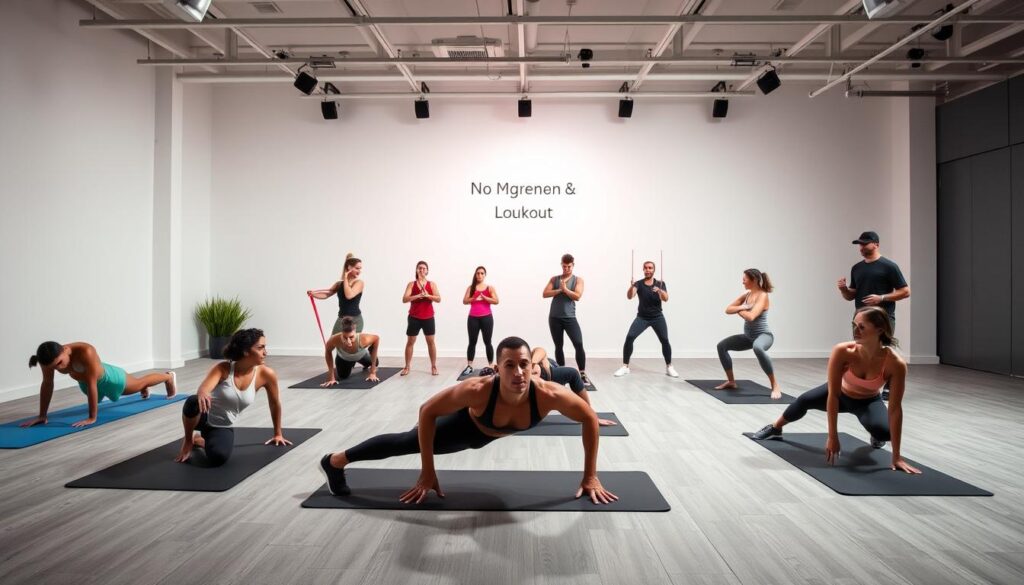
Designing an effective exercise routine is simpler than you might think. With a few strategic moves, you can create a full-body circuit that targets all major muscle groups. This approach ensures you maximize your time and effort while achieving your fitness goals8.
Building a Full-Body Circuit
A well-rounded routine includes compound movements like squats, lunges, and push-ups. These exercises engage multiple muscle groups, making them efficient for strength and endurance. For example, squats work your legs, glutes, and core, while push-ups target your arms, shoulders, and chest9.
Start with a basic circuit: 20 squats, 10 push-ups, and a 30-second plank. Repeat this sequence 3 times for a complete workout. This structure ensures you’re working your entire body without needing any equipment8.
Customizing Intensity and Reps
Adjusting the number of reps and rest periods can tailor the workout to your fitness level. Beginners might start with 10 reps per exercise and 60 seconds of rest. As you progress, increase reps to 20 and reduce rest to 30 seconds10.
Progressive overload is key to improvement. Gradually add more reps, increase speed, or incorporate advanced variations like jump squats or one-legged lunges. Tracking your progress helps you stay motivated and see results over time9.
Tip: Mix strength and cardio exercises for enhanced fat burn. For example, add jumping jacks or mountain climbers between sets to keep your heart rate elevated8.
By designing a routine that fits your goals and fitness level, you’ll create a sustainable path to better health and strength. Remember, consistency is more important than intensity—small steps lead to big results10.
Effective Warm-Up Techniques for Home Workouts
A proper warm-up is the foundation of any effective exercise routine. It prepares your muscles, boosts your heart rate, and reduces the risk of injury. Spending just five minutes on dynamic movements can significantly enhance your workout performance11.
Dynamic Movements to Activate Muscles
Start with arm circles to improve blood flow and flexibility. Perform this movement for 30 to 60 seconds to loosen up your shoulders and arms11. Next, try forward leg swings to activate your hips and legs. This exercise is especially helpful for lower body workouts like squats and lunges11.
Incorporate jumping jacks to elevate your heart rate and oxygen flow. This full-body movement is perfect for getting your energy up before high-intensity training11. For core engagement, add knee lifts, which also help improve balance and stability11.
Simple and Quick Safety Tips
Always begin with easier variations of exercises to build confidence and prevent strain. For example, start with assisted squats or modified push-ups if you’re new to training12. Focus on proper alignment—keep your knees over your toes during squats and your back straight during planks11.
Gradually increase the intensity of your warm-up to avoid overexertion. Monitor your heart rate and flexibility as indicators of readiness12. Transition smoothly into your main routine to maintain momentum and focus.
Pro Tip: Use controlled breathing during your warm-up to enhance oxygen flow and calm your mind. This practice sets the tone for a productive session11.
Key Bodyweight Exercises to Burn Fat and Build Muscle
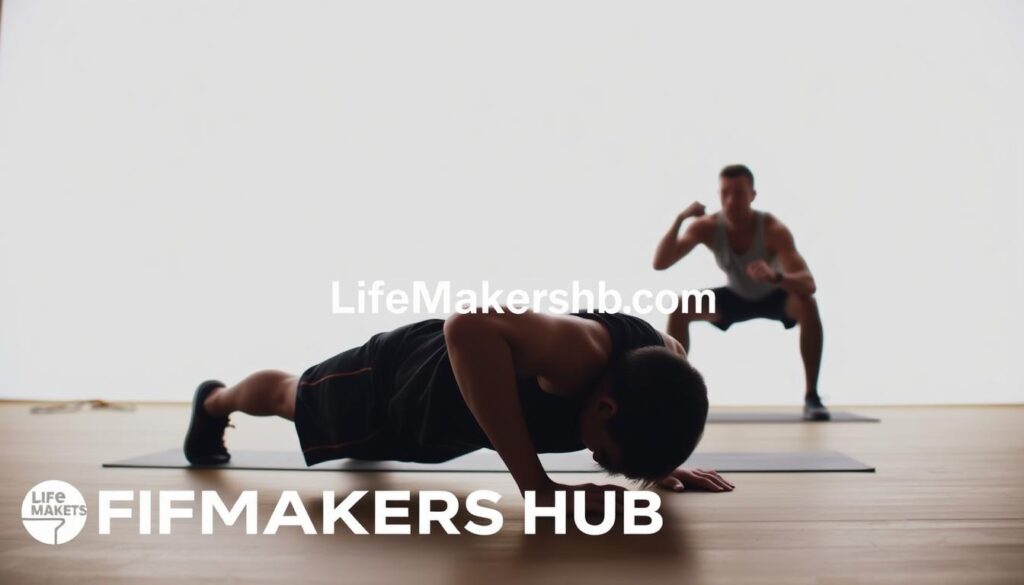
Bodyweight exercises are a powerful way to transform your fitness journey. These moves target multiple muscle groups, helping you burn fat and build strength without needing any equipment. Whether you’re a beginner or advanced, these exercises can be tailored to your fitness level for maximum results13.
Lower Body Focus: Squats and Lunges
Squats and lunges are foundational moves for strengthening your legs, glutes, and hips. Start with basic squats, keeping your knees aligned with your toes and your back straight. For lunges, step forward with one leg, lowering your hips until both knees are at 90 degrees13.
Perform 3 sets of 8 to 10 reps per leg for lunges, or try 45 seconds of work followed by 15 seconds of rest for a timed approach13. These exercises not only build muscle but also improve balance and coordination.
Upper Body and Core Strengthening Moves
Push-ups and planks are excellent for targeting your arms, shoulders, and core. For push-ups, keep your hands shoulder-width apart and lower your body until your chest nearly touches the floor. Beginners can modify this by performing knee push-ups14.
Planks engage your entire core. Hold the position for 30 to 60 seconds, keeping your body in a straight line from head to heels. For added intensity, try side planks or bicycle crunches13.
Pro Tip: Combine these exercises into a circuit for a full-body workout. For example, alternate squats, push-ups, and planks with minimal rest to keep your heart rate elevated14.
Consistency and proper form are key to seeing results. Start with manageable reps and gradually increase intensity as your strength improves. These exercises not only enhance muscle tone but also boost your metabolism for long-term fat burn13.
Circuit Training and HIIT for Maximum Fat Burn
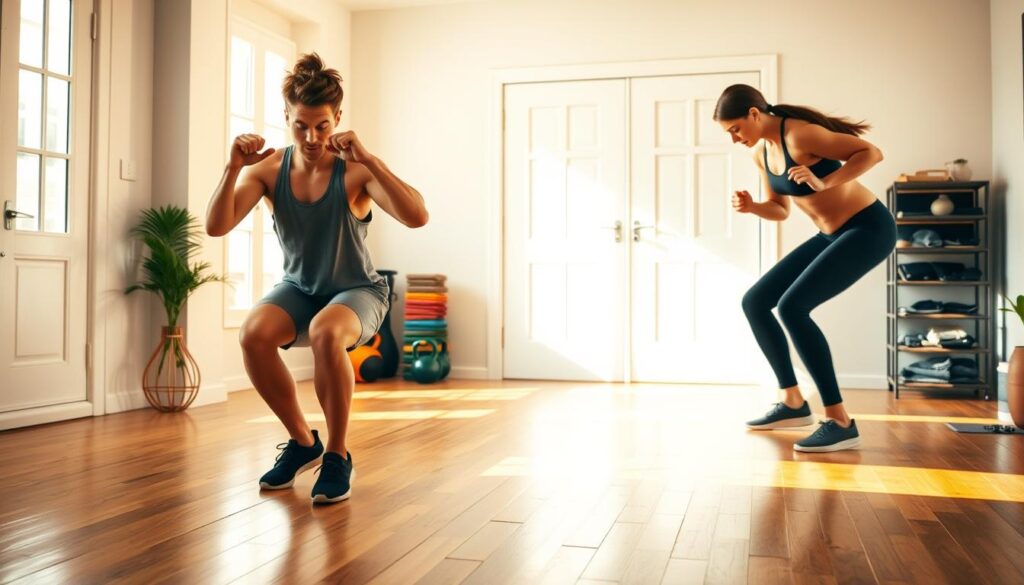
Maximizing fat burn and building endurance can be achieved through structured, high-intensity routines. Circuit training and HIIT (High-Intensity Interval Training) are two powerful methods that combine strength and cardio for quick, effective results. These approaches are designed to push your limits while keeping workouts engaging and efficient15.
Creating a High-Intensity Circuit
Circuit training involves performing a series of exercises back-to-back with minimal rest. This method keeps your heart rate elevated, maximizing calorie burn and improving cardiovascular fitness. A typical circuit might include squats, push-ups, and mountain climbers, targeting multiple muscle groups in one session16.
To structure your circuit, choose 4-6 exercises and perform each for 30-40 seconds. Rest for 10-20 seconds between movements, then repeat the circuit 2-3 times. This approach ensures you’re working your entire body while keeping the intensity high15.
Integrating HIIT for Quick Results
HIIT involves short bursts of intense activity followed by brief recovery periods. For example, you might sprint for 20 seconds, then walk for 10 seconds, repeating this cycle for 10-15 minutes. This method is proven to boost metabolism and burn calories long after the workout ends16.
Studies show that HIIT can reduce body fat and improve cardiovascular health more effectively than steady-state cardio15. It’s also time-efficient—just 20 minutes of HIIT can deliver the same benefits as a 40-minute jog16.
Pro Tip: Combine strength moves like lunges with cardio elements like jumping jacks to create a balanced HIIT routine. This approach keeps your heart rate up while building muscle15.
By incorporating circuit training and HIIT into your routine, you’ll see faster results in less time. These methods are adaptable to any fitness level, making them a smart choice for anyone looking to boost their fitness journey16.
Nutrition and Recovery: The Other Side of Weight Loss
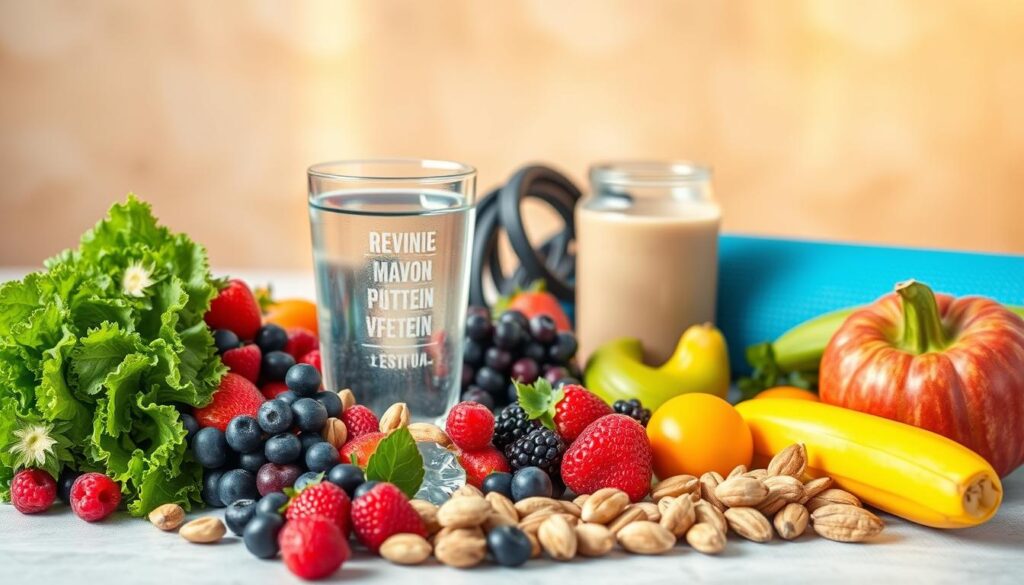
Achieving sustainable weight loss requires more than just exercise—it’s about balancing nutrition and recovery. While physical activity is crucial, what you eat and how you rest play equally important roles in reaching your goals17.
Nutrition fuels your body, while recovery allows it to repair and grow stronger. Together, they create a foundation for long-term success. Let’s explore how to optimize both for maximum results.
Eating Strategies for a Caloric Deficit
To lose weight, you need to consume fewer calories than you burn. This is called a caloric deficit. Start by tracking your daily intake using tools like calorie counters or apps17.
Focus on portion control and balanced meals. Include lean proteins, whole grains, and plenty of vegetables. High-protein foods support muscle recovery and reduce cravings, while fiber-rich options keep you full longer18.
Pro Tip: Plan your meals ahead of time to avoid unhealthy choices. A balanced plate with proteins, carbs, and healthy fats ensures steady energy throughout the day19.
Importance of Rest and Recovery
Rest is just as important as exercise. During recovery, your muscles repair and grow stronger. Aim for 7-9 hours of quality sleep each night to support this process17.
Incorporate rest days into your routine. Overworking your body can lead to fatigue and injury. Listen to your body—if you’re feeling sore or tired, take a break18.
Hydration also plays a key role in recovery. Drink plenty of water to support metabolism and overall health. Proper hydration helps your body function at its best19.
By combining smart nutrition with adequate rest, you’ll create a sustainable path to weight loss. Remember, it’s not just about the workout—it’s about the lifestyle you build around it.
Adding Variety with Advanced Workouts and Fun Challenges
Keeping your fitness routine fresh and exciting is key to long-term success. By introducing advanced exercises and creative challenges, you can prevent boredom and keep your body continually adapting. This approach not only boosts motivation but also ensures balanced muscle development20.
Progressive Overload and Exercise Variations
Progressive overload is essential for muscle growth and strength. Gradually increase reps, intensity, or difficulty to challenge your body. For example, try jump squats instead of regular squats or add a side plank to your core routine21.
Variations like single-leg lunges or push-ups with a clap can target muscles from different angles. This prevents plateauing and keeps your workouts effective. Always focus on proper form to avoid injury20.
Creative Routines: From Star Wars Workouts to Playground Circuits
Inject fun into your routine with themed workouts. The Star Wars Workout, for instance, combines strength and cardio with imaginative moves. Playground circuits use equipment like swings and monkey bars for a full-body challenge21.
These creative ideas make exercise enjoyable and engaging. They also encourage consistency, which is crucial for long-term results. Plus, they’re a great way to involve friends or family20.
| Traditional Workouts | Creative Workouts |
|---|---|
| Repetitive and predictable | Fun and engaging |
| Limited muscle targeting | Balanced muscle development |
| Risk of plateauing | Continuous adaptation |
| May lack motivation | Boosts enthusiasm |
By adding variety to your routine, you’ll stay motivated and see better results. Whether it’s through advanced moves or fun challenges, keep pushing your limits in a safe and controlled way21.
Conclusion
Taking control of your fitness journey starts with simple, effective steps. By focusing on bodyweight movements like squats, lunges, and planks, you can build strength and improve your overall fitness. These exercises target key muscle groups, from your legs and glutes to your core and upper body, making them efficient for any routine22.
A balanced approach is essential. Combine dynamic warm-ups, proper form, and post-workout recovery to maximize results. Studies show that consistency in exercise, paired with sound nutrition, leads to sustainable progress23.
One of the biggest advantages is convenience. Without the need for a gym or equipment, you can stay active anytime, anywhere. This flexibility makes it easier to stick to your goals and maintain a healthy lifestyle24.
Start with the basics and gradually add advanced elements as you grow stronger. Track your progress, experiment with different routines, and join supportive communities to stay motivated. Remember, every step forward is a step toward better health.
Take the next step today. Your fitness journey is yours to shape—empower yourself with the tools and knowledge to succeed.
FAQ
What are the best exercises for a full-body workout without equipment?
How can I make my home workouts more challenging?
How often should I do bodyweight exercises for optimal results?
Can I build muscle with no-equipment workouts?
What’s the best way to warm up before a home workout?
How do I track progress without weights or machines?
Are HIIT workouts effective for fat loss at home?
What should I eat to support my fitness goals?
How can I stay motivated with home workouts?
Source Links
- Bodyweight Workout for Beginners (20-Minute at Home Routine)
- 40 At-Home Exercises for Weight Loss Without Equipment – OVYVO Medical Weight Loss
- No title found
- No title found
- Here Are 5 At-Home Workouts To Lose Weight
- Home Workouts: More Effective Than the Gym?
- Strength Training at Home: Workouts With and Without Equipment
- The 10 Best at Home Workouts (No-Equipment!) | Nerd Fitness
- Easy At-Home Workout Routine [No Equipment Required] – Perfect Keto
- The Best 20-Minute Full-Body Workout You Can Do Anywhere
- Trainers Created The Most Effective 5-Minute Warm-Up For Every Workout
- The 10-Minute Perfect Morning Home Workout
- Unlock True Strength with These 20 Bodyweight Exercises
- Bodyweight Workout | Home Bodyweight Exercises | ATHLEAN-X
- 20 best *free* HIIT workouts for every level
- 3 HIIT Workouts For Weight and Fat Loss
- Zealthy
- The 8 Best Exercises for Weight Loss
- The 6-Week Strength Workout Plan to Lose Fat Fast
- The 20 best cardio exercises to do at home
- 13 At-Home Workout Programs If You Just Want Someone to Tell You What to Do
- No Weights, No Problem: The Benefits of Bodyweight Training
- Can a Home Workout Be as Effective as a Gym? – Gymondo® Magazine: Fitness, Nutrition & Weight Loss
- Beginner’s Guide to Home Workouts – With and Without Weights

